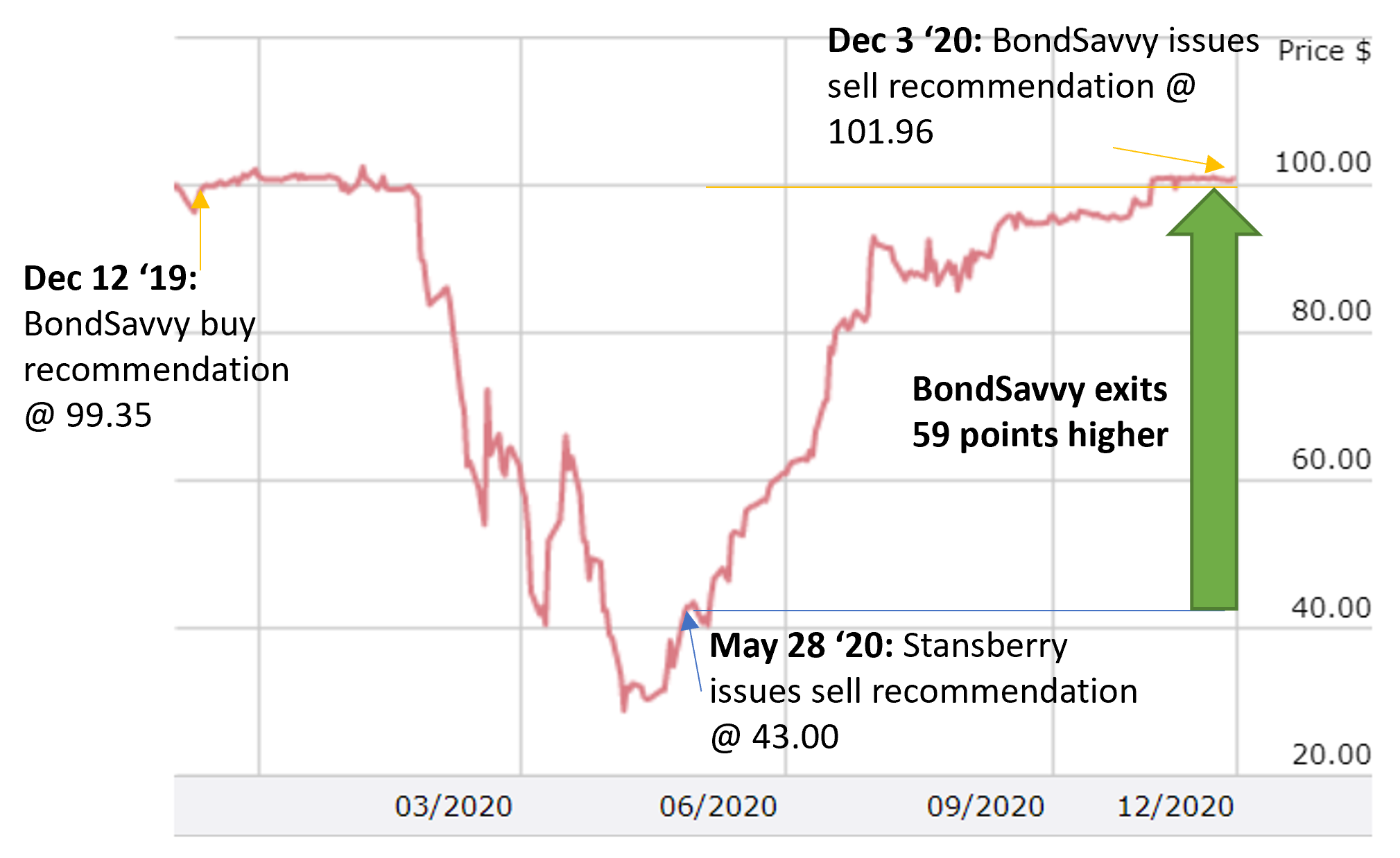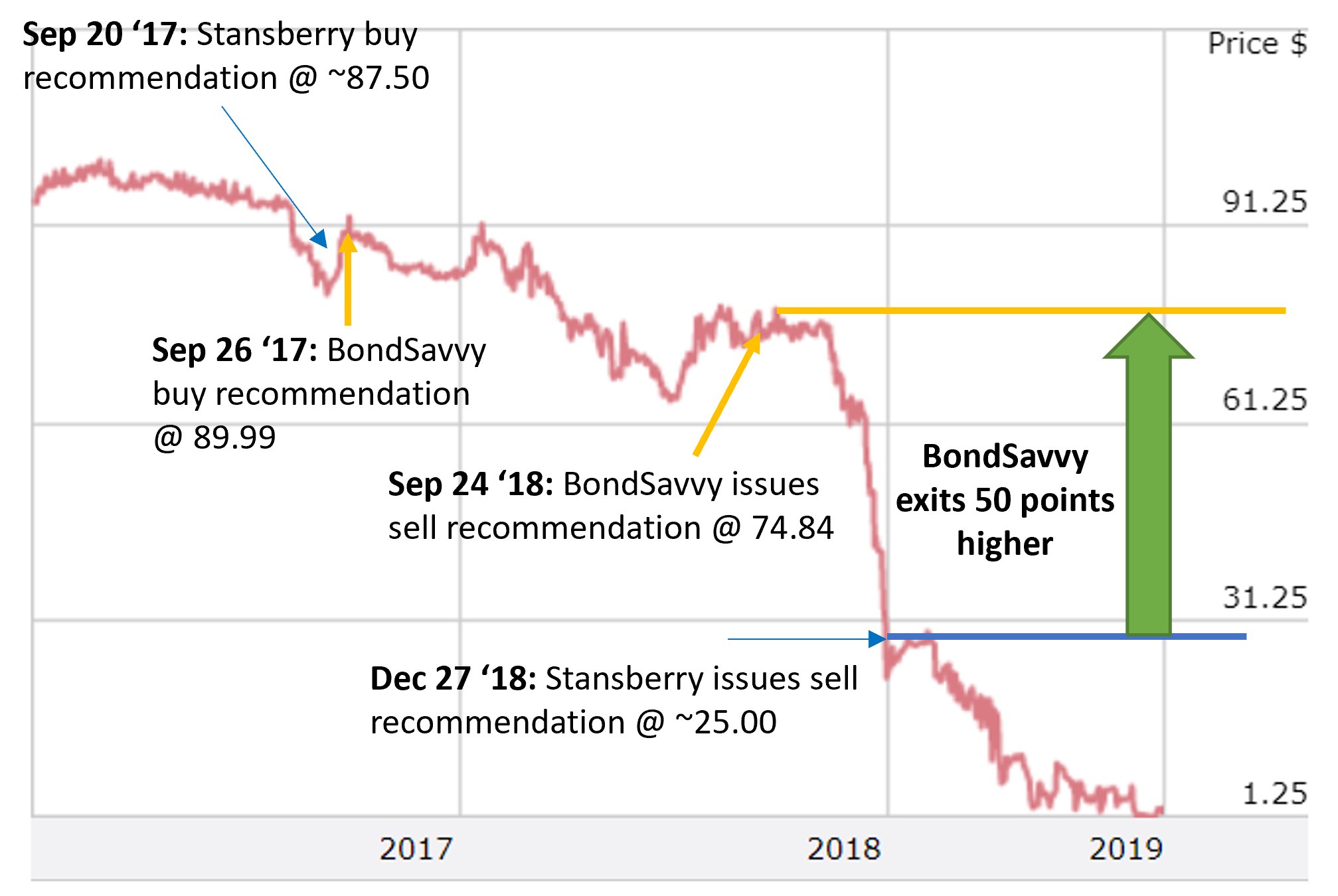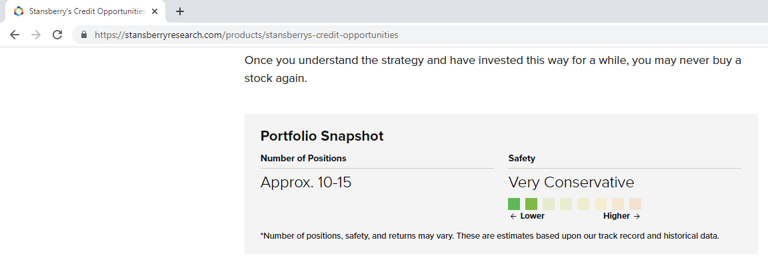If you want individual corporate bond recommendations that have beaten
the most popular corporate bond
ETFs 76% of the time and to pay a fee relatively small to the returns historically generated, then Bondsavvy could
be for you. We believe Bondsavvy is the only US investment newsletter focused exclusively on individual
corporate bonds.
This fixed income blog post compares Bondsavvy to Stansberry Credit
Opportunities, a competing investment newsletter
published by Stansberry Research that previously recommended bonds but now recommends mostly preferred stocks and
'hybrid' securities.
Why Choose Bondsavvy over Stansberry Credit Opportunities
Figure 1 lists ten reasons to subscribe to
Bondsavvy rather than the Stansberry Credit
Opportunities investment newsletter. Later in this fixed income blog post, we discuss the key differences
among Bondsavvy, Stansberry Credit Opportunities, and another investment newsletter known as the Forbes Lehmann
Income Securities Investor. Later, we review the details of each of the ten reasons investors should choose
Bondsavvy over Stansberry Research.
Figure 1: Ten Reasons to Subscribe to
Bondsavvy over Stansberry Credit Opportunities
Bondsavvy Reviews vs. Stansberry Credit Opportunities Reviews
This fixed income blog post provides our perspective on the advantages of Bondsavvy vs. Stansberry Credit
Opportunities. In addition to our analysis, an investor who subscribes to both Bondsavvy and Stansberry Credit
Opportunities wrote the following on the Bondsavvy reviews page:
 |
"I searched long and hard for a service to help me with
corporate bond investing. I have been VERY pleased with Bondsavvy. Overall, the recommendations have
been good. The educational component is outstanding. And Steve is VERY responsive to
subscriber needs and questions. FWIW....I am also a
subscriber to Stansberry's bond newsletter. This product is head and shoulders above
theirs."
-- Eric S., Michigan, February 10, 2021 |
Bondsavvy vs. Stansberry Credit Opportunities
While there are several investing for income newsletters, investors should not be led to believe that "income" means
bonds. For example, the Forbes Lehmann Income Securities Investor peddles common stocks, preferred stocks,
closed-end funds, MLPs, etc. In the sample Income Securities Investor newsletter for March 2021, it did not
have a single new individual bond recommendation.
Figure 2 provides a brief comparison among Bondsavvy, Stansberry Credit Opportunities, and the Forbes Lehmann Income
Securities Investor newsletter. After the table, we discuss the ten reasons investors should choose Bondsavvy over Stansberry Credit
Opportunities.
Figure 2: Comparison of Bondsavvy to Competing Investment Newsletters
TEN REASONS TO SUBSCRIBE TO BONDSAVVY VS. STANSBERRY CREDIT
OPPORTUNITIES
REASON #1

Stansberry Research does
not disclose investment returns for all of its recommendations. Bondsavvy does.
Bondsavvy's corporate bond returns page
shows the
investment returns for the 82 corporate
bond recommendations Bondsavvy made since the first edition of The Bondcast on September 26,
2017 through May 2021. We disclose the names and CUSIPs of all exited recommendations and investment returns details
for current buy/hold
recommendations. This provides full transparency to prospective investors so they can see the types
of individual corporate bonds we have previously recommended and
the returns the recommendations have achieved.
Through
December 31, 2021, 76% of Bondsavvy's investment recommendations have beaten iShares LQD and HYG, the leading
corporate bond ETFs. Thirty-seven percent (37%) of Bondsavvy's recommendations have beaten the iShares
corporate bond ETFs by at least ten percentage points.
In addition to showing our investment
returns, we provide
prospective subscribers with two free sample editions of
The Bondcast,
where investors can see the investment analysis that accompanies new Bondsavvy corporate bond
recommendations.
Stansberry Credit Opportunities provides no detailed investment returns data
In
reviewing its website, Stansberry Research does not provide one example of a previous recommendation and its
return. Nada. It shows an alleged annualized return, but the time period is not clear, and we don't
know how it's calculated. Since it annualizes its returns, it could have a few past recommendations with
mega returns and a bunch of duds. We also don't know the amount of defaults across the investment
newsletter's previous recommendations. With Stansberry Research, investors are left in the dark.
REASON
#2

Bondsavvy issued sell recommendations at prices a combined 109 points higher than
Stansberry Research for the two known recommendations we have in common.
In reviewing the Stansberry Credit Opportunities website,
we are aware of two bonds where we both recommended buying and then later selling the same bond:
- Tupperware 4.75% 6/1/21 (CUSIP 899896AC8)
- Monitronics 9.125% 4/1/20 bond (CUSIP 609453AG0)
While neither of these bond picks will make the Bondsavvy Hall of Fame, we exited the Tupperware '21 bond
approximately 59 points higher than Stansberry Research and the Monitronics '20 bond approximately 50 points higher
than Stansberry Research. Below are case studies on the Tupperware and Monitronics bond recommendations:
Tupperware '21 Case Study
Both Bondsavvy and Stansberry Research
recommended the Tupperware 4.75% 6/1/21 bond (CUSIP 899896AC8). We recommended the Tupperware bonds December
12, 2019 at 99.35 and sold them December 3, 2020 at 101.96 for a total return of 7.30% compared to a 4.40% return
for the iShares HYG corporate bond ETF. Per Figure 3, Stansberry Credit Opportunities issued a 'sell' of the
Tupperware '21 bonds on May 28, 2020, at which time the bonds were trading at 43.00.
Figure 3: Tupperware '21 Bonds -- Comparison of Bondsavvy vs. Stansberry Research Sell
Recommendations

Pricing data provided by FINRA
market data.
During 2020, we issued six updates on the Tupperware bonds. While the first part
of 2020 was ugly for the company, it did start to improve performance and, on November 2, 2020, it received a
financing commitment so it could redeem the 4.75% '21 bonds.
Monitronics '20 Case Study
Both Bondsavvy and Stansberry Research
recommended purchasing the Monitronics 9.125% 4/1/20 bond (CUSIP 609453AG0) in late September 2017. There were
terms in the company's bank agreements that required Monitronics to refinance the '20 bonds well in advance of the
April 1, 2020 maturity date. This shot clock and the company's weak performance put downward pressure on the
bonds, as shown in Figure 4.
After another quarter of weak performance and in the midst of attempted tender
activity for the bonds, Bondsavvy recommended selling the bonds on September 14, 2018 at a price of 74.84,
registering a total return of -7.13%, our fourth-worst return across the 49 bonds we have sold through December 31,
2021. Stansberry Research advised subscribers to keep holding the bonds until December 27, 2018, when it
finally issued a sell on the Monitronics bond, as shown in Figure 4. At this time, the bonds were trading at
approximately 25.00, approximately 50 points lower than the Bondsavvy sell recommendation.
Figure 4: Monitronics '20 Bonds -- Comparison of Bondsavvy vs. Stansberry Research
Sell Recommendations

Pricing data provided by FINRA market data.
From our reading of the Stansberry Research website, it does not appear that it provides quarterly updates on all of
its bond recommendations but rather provides updates on an ad hoc basis: often times, when it's too
late.
REASON #3

Stansberry Credit Opportunities only recommends 10-15 securities, many of which
are not bonds. Bondsavvy offers subscribers more choice, with a current recommended list of 48 individual
corporate bonds.
We believe it's important for investors to own both investment grade and high yield corporate bonds, as opportunities
arise in different types of bonds over time. Bond investors should not be one-trick ponies. Some of
Bondsavvy's highest investment returns have been from investment grade corporate bonds we recommended purchasing at
significant discounts to par value.
But Stansberry Credit Opportunities only recommends a small portfolio of 10-15 securities, which includes preferred
stocks, convertible preferreds, tangible equity units, and a few high yield bonds. Bondsavvy's recommended
list currently includes 37 individual corporate bonds across both investment grade and high yields bond
ratings.
Bondsavvy seeks to serve investors with a variety of risk appetites. While we take the universe of
approximately 9,000 tradeable corporate bonds down to fewer than 40, our list provides variety across credit
quality, industry sector, and maturity dates. As we write this fixed income blog post, we recommend corporate
bonds across 11 industry groups.
Presumably, Stansberry Credit Opportunities recommends bonds that can be bought via online bond trading platforms
such as Fidelity and E*TRADE. If it focuses on "distressed" corporate bonds, it's currently a very small
universe, with heavy industry concentration. Based on a Fidelity
bond search we conducted September 1, 2021, only 12 high yield corporate bonds had offer prices lower
than 80.00. Four of these bonds were issued by movie theater chains and eight were issued by companies in the
energy sector.
REASON #4

Stansberry Research does not appear to update each recommendation on a
regular basis. Bondsavvy updates its 35+ buy/hold recommendations each quarter and provides
supplemental updates as needed.
For Bondsavvy, our work only begins
when we make an initial buy
recommendation during The Bondcast. Once we make a new bond recommendation, we update our
buy/sell/hold ratings every quarter based on each bond issuer's financial performance and the updated pricing of our
recommended bonds. We update these recommendations during The Super Bondcast, a quarterly
webcast series exclusively available to Bondsavvy's subscribers, which follows quarterly earnings releases. As
part of our bond recommendation updates, we post updated bond prices, YTMs, credit spreads, and leverage ratios in our subscriber dashboard
area.
In addition to our regularly scheduled quarterly updates, Bondsavvy may provide additional updates,
especially during times of market unrest. For example, during 2020, Bondsavvy provided subscribers with 30
email updates on its bond recommendations in addition to our regularly scheduled subscriber
webcasts.
Important to monitor all bonds on our recommended list
A key part of our fixed income investment strategy is
selling bonds before
maturity to maximize capital
appreciation and total investment return. Carefully monitoring the quarterly financial performance of each
Bondsavvy-recommended issuer enables us to determine the level of possible upside -- or downside -- in our
recommended corporate bonds.
REASON #5

Stansberry Credit Opportunities rarely recommends new bonds, favoring preferred stock and other equity
securities. Bondsavvy exclusively recommends individual corporate bonds.
Bondsavvy believes in full transparency. It starts with disclosing the investment returns of each bond recommendation
on the
public portion of the Bondsavvy website and in our subscriber area. We believe more individual investors need
exposure to individual corporate bonds given the advantages of bonds vs. bond funds and bonds vs. stocks. We founded Bondsavvy to empower
investors to benefit from the income, growth, and capital preservation individual corporate bonds can provide.
It's the primary mission of our company.
The name "Stansberry Credit Opportunities" is misleading and does
not accurately represent what the newsletter sells. In reviewing the Stansberry
Research website, of the nine recommendations it
describes for 2021, six were for 'hybrid' securities (typically something like a tangible equity unit...Google it),
two were for preferred stock, and one recommendation was for a bond. The word "credit" implies debt.
That the substantial majority of Stansberry Credit Opportunities' 2021 recommendations were for equity securities
speaks to Stansberry Research's lack of credibility and transparency.
REASON #6

Stansberry Research misleads investors by labeling distressed bonds and its
preferred stock and 'hybrid' recommendations as "Very Conservative."
Investment service providers,
including Bondsavvy and Stansberry Research, must provide
prospective subscribers with an accurate assessment of the risks associated with their recommendations.
Bondsavvy does this by disclosing the investment returns of its bond recommendations on its corporate bond returns page, where investors
can see
the range of investment returns we have achieved.
Our recommendations include corporate bonds with bond ratings below investment
grade. We also
recommend investment grade corporate bonds with, generally speaking, over 10 years to maturity. While these
investments are safer than stocks, they can be volatile. "Very conservative" investments, in our eyes, are
savings accounts and investments in short-dated investment grade corporate bonds.
It is, therefore,
inexplicable that Stansberry Research misleads prospective investors by labeling its strategy as "Very Conservative"
on its website, as shown in Figure 5. Distressed corporate bonds, Stansberry Credit Opportunities' alleged
focus, are the most risky part of the corporate bond market. These investments are anything but
conservative. In addition, based on our review of the Stansberry Research website, the company seems to have
recommended a fair number of bonds that have later defaulted.
Further, Stansberry Credit Opportunities
now recommends preferred stocks, convertible preferred stocks, and, on May 19, 2021, the tangible equity units of a
pet
pharmaceutical company. These investments, along with the company's distressed debt investments are all
high-risk investments. Stansberry Research labeling this strategy as "Very Conservative" is very
misleading in our book.
Figure 5: Snapshot of
Stansberry Credit Opportunities Risk Assessment

Source: Stansberry Research
REASON #7

A key Bondsavvy
goal is for our subscribers to be able to buy and sell corporate bonds at or near the prices at which we recommend
them. During 2021, we took several actions to limit the market impact our recommendations have on the
prices of our recommended bonds. We carefully monitor the prices at which corporate bond trades are executed
in the days following our recommendation dates.
Across 87 previous corporate bond recommendations, we have
seen a material market impact on two recommended bonds, both of which we recommended December 17, 2020. As we
took actions during 2021 to limit our market impact, we have been pleased to see limited market impact so far this
year.
To illustrate, our recent fixed income blog post previews the best
bonds we recommended on September 9, 2021 and the corporate bond trading activity for the four trading
days leading up to our pick date and the four trading days immediately following our pick date. We chart each
customer buy trade and calculate the average price at which customer buy trades were executed the day following our
recommendation date.
Bondsavvy founder Steve Shaw
knows the inner workings
of how corporate bonds trade online from his experience leading Tradeweb direct and as a senior executive at
BondDesk Group, two leading online bond trading systems. He has presented the state of the US corporate
bond market
for individual investors to the US Securities & Exchange Commission.
Limiting market impact
will always be top of mind at Bondsavvy, and Steve Shaw's corporate bond market experience equips him well to
address this issue.
REASON #8

Stansberry Credit Opportunities' fees are expensive for what you
get. Bondsavvy
subscribers get
more and pay
less.
Bondsavvy's goal is for our
subscription fee to be a small portion of the investment returns our recommendations generate. For subscribers
purchasing 10 bonds of every Bondsavvy recommendation through the May 2021 edition of The Bondcast, they
have earned $63 in returns for every $1 paid in Bondsavvy subscription fees through October 29, 20211.
We also
want our fee to be a small portion of the dollar amount a subscriber invests in individual corporate bonds.
Investment returns will vary over time, and keeping subscription fees at a reasonable level helps subscribers
maximize returns over the long term. As of this writing, Bondsavvy's one- and two-year fees were $625 and
$1000, respectively.
In reviewing the Stansberry Research website, it appears the Stansberry Credit
Opportunities newsletter has issued one or two corporate bond recommendations for all of 2021. At a $3000
annual subscription fee, subscribers are paying either $1500 or $3000 for each recommended bond. Ouch.
Stansberry Research appeared to issue 8-10 additional recommendations of either preferred stock, convertible
preferred stock, tangible equity units, and other equity instruments. We would hate to be the person who paid
$3000 thinking he was going to get bond recommendations and, instead, received a bunch of risky equity
recommendations.
While we do not have investment returns data across all of Stansberry Research's corporate
bond recommendations, given its poor relative performance in the two bond picks we had in common (See Reason #2),
it's doubtful it is producing compelling investment returns across the few corporate bond recommendations it has
made.
REASON #9

Stansberry Credit Opportunities reviews average 2.5 out of
5.0. Bondsavvy subscriber reviews average
4.9 out of 5.0.
The
jury is in, and subscribers strongly prefer Bondsavvy to the Stansberry Credit Opportunities investment
newsletter. Prospective subscribers can view the Bondsavvy reviews page to see what our subscribers
think of the Bondsavvy investment service. We believe they provide a good flavor for the experience our
subscribers receive.
Stansberry Credit Opportunities only posts about two subscriber reviews on its
site. More Stansberry Credit Opportunities reviews are available on the Stock Gumshoe website. Many of the reviews
voice similar concerns to those mentioned in this fixed income blog post, including that the marketing misrepresents
the service and there are a large number of defaults relative to the newsletter's small number of investment
recommendations.
REASON #10

Stansberry Credit Opportunities is continually bearish on corporate bonds,
regularly predicting "The Coming Credit Collapse."
After reviewing the Stansberry
Research website, we believe we have found why the company no longer recommends corporate bonds: they
don't believe in them. Investment websites are filled with experts and market gurus falling over themselves to
predict the next disaster. While these provocative titles stir panic and may sell subscriptions, they are
typically a disservice to investors.
Below is a list of recently published Stansberry Research
newsletters proclaiming the pending fall of the corporate bond market:
December 17, 2021: "Your Complete Guide to the Coming Credit
Collapse"
December 15, 2021: "Get Ready for the 'Mother of All
Crashes' in 2022
January 20, 2021: "Don't Let the Calm Fool You"
where Stansberry Research lays out its "strategy for surviving the next credit collapse"
April 24, 2020: "Mike DiBiase on the Corporate Debt Bubble"
April 15, 2020: "The Corporate Debt Bubble Is Popping"
November 21, 2018: "Preparing for the 'Volcano' to Erupt" where
Stansberry Research explains "that massive pressure is building beneath the surface of the corporate bond
market."
Bondsavvy's perspective on this is straightforward. There will be times when individual
corporate bonds outperform other asset classes and times when they underperform. Over the long term, however,
we believe individual corporate bonds will outperform bond funds and, in certain periods, stocks.
We
have been able to outperform the leading bond funds by identifying individual corporate bonds that offer strong
yields and potential returns relative to their risk. As of our last bond update on December 3, 2021, 27 of 37
recommended bonds were issued by companies that had leverage
ratios of 3.0x or lower as of the most recent financial reporting period. All of our bond issuers
had leverage ratios less than 4.0x.
Many market pundits have cited a so-called BBB bond bubble. There
are many bond issuers that are, admittedly, IGINO (investment grade in name only) and have financials that don't
support their lofty bond ratings. Our job is stay away from those bonds and others with high risks of
default.
We do not believe in blanket statements such as the ones regularly made by Stansberry
Research. The astute bond investor can find opportunities across a variety of market conditions.
CONCLUSION
Steve Shaw founded Bondsavvy so
more individual investors could benefit from the income, growth, and principal protection individual corporate bonds can provide.
Very few investors own individual corporate bonds, and Steve founded Bondsavvy to change this.
Through his work at Tradeweb and BondDesk Group, Steve saw firsthand how technology had made corporate bond investing
fair for individual investors. As Steve presented the US corporate bond market for individual investors to the US SEC in 2018,
the corporate bond market has over 100 dealers that provide live bid-ask quotes for approximately 9,000 individual
corporate bonds each day. Bid-ask spreads are reasonably narrow, and, often times, someone buying 10 bonds can
get a price as good -- or even better -- than a large bond fund purchasing millions of the same bond.
We believe owning individual corporate bonds direct positions investors to maximize returns, limit fees, and know
exactly what is in their portfolios. Selecting among the 9,000 available individual corporate bonds can be a
daunting task for many investors, which is why Bondsavvy recommends a highly curated list of individual corporate
bonds investors can use to decide which bonds are right for them.
Get Started
Watch Free Sample
1Read
our investment
returns calculation page to see assumptions used in this calculation and relevant footnotes.